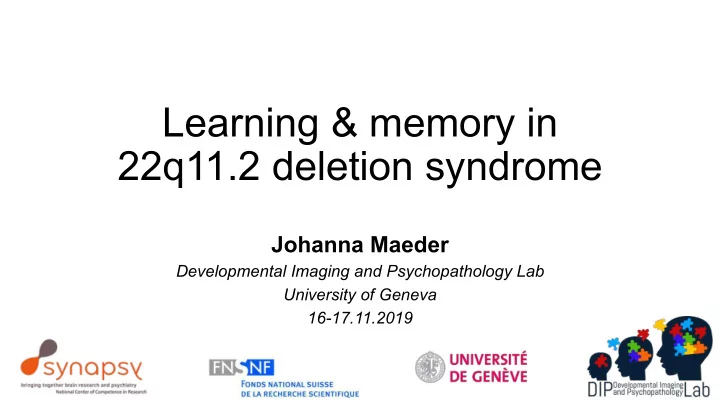

Learning & memory in 22q11.2 deletion syndrome Johanna Maeder Developmental Imaging and Psychopathology Lab University of Geneva 16-17.11.2019
Learning & memory Ability to acquire, store and recall information over time Event Word meaning Skills Hippocampus is a key structure in the brain Hippocampus Reduction of the volume have been consistently demonstrated in 22q11.2DS From Mancini et al. 2019, Mol. Psych.
Learning & memory in 22q11.2DS Numerous previous studies on memory have shown verbal > non verbal Few have focused on the different steps leading to memory impairments Acquisition? Storage? Recall? Memory is tested with paradigms including immediate and differed recalls (30 minutes) Consolidation of memory happens over longer delays (days, weeks, months) What happens after 30 minutes? Bostelmann et al., 2017;Campbell et al., 2010; Debbané et al., 2008; Lajiness-O’Neill et al., 2005
Task design Inspired by Rey’s Auditory Verbal Learning Test (RAVLT, 1958) Verbal information = 15 common French words Table, cat, moon, car, … Non-verbal information = 15 drawings made out of 1 or 2 basic geometrical forms Learning criterion : 80% (12 items) or max. 6 presentations Adapted recall design : Learning Recall 1 Recall 2 Recall 3 Recall 4 phase D + D + D + D + D 30 minutes one day one week one month
N= 135 (78 with 22q11.2DS) Results on learning Learning phase Age range: 8-25 D Information acquisition Highest. Nb. Items recalled Learning Score = VERBAL Nb. Trials necessary to reach criterion Table, cat, moon, car, … ** Comparable trajectories of learning over time 8 Similar performances from trial 1 ** Same amount of trials necessary to reach criterion 6 Learning score NON-VERBAL 4 2 Lower performances from trial 1 in 22q11.2DS Slower increase over time in 22q11.2DS 0 More trials needed to reach criterion in 22q11DS VERBAL NON-VERBAL Controls 22q11.2DS ** p <0.001 From Maeder et al. Under review
N= 84 Results on verbal memory Learning Recall 1 Recall 2 Recall 3 Recall 4 phase Age range: 8-25 Table, cat, moon, car, … D + D + D + D + D 30 minutes one day one week one month Group effect p < 0.001 Interaction p < 0.001 Significant difference in shape between groups Significantly lower performance after delays of 30 minutes Evidence for accelerated long-term forgetting (ALF) (Shape with IQ as a covariate: p <0.001) • Controls (N = 39) • 22q11.2DS (N = 45) D From Maeder et al. 2019, Child Neuropsychol.
Subgroups in 22q11.2DS Within 22q11.2DS Group effect p < 0.001 Hippocampus Interaction p < 0.001 p = 0.021 ; g = 0.95 p = 0.039 ; g = 0.76 Right Global Hippocampal Volume 4000 4200 Left Global Hippocampal Volume 4000 3800 Right Global Hippocampal Volume Left Global Hippocampal Volume 3800 3600 3600 3400 3400 3200 3200 3000 3000 • Controls (N = 39) 2800 2800 • 22q11.2DS_HIGH (N = 32) 2600 2600 3 High Memory Low Memory 0 0.5 High Memory 1 1.5 Low Memory 2 2.5 3 0 0.5 1 1.5 2 2.5 3 • 22q11.2DS_LOW (N = 12) Retention Retention Retention Retention • 22q11.2DS_HIGH (N = 32) • 22q11.2DS_LOW (N = 12) Characteristics of the 22q11.2DS LOW memory group Lower IQ Higher rates of psychotic symptoms Reduction of hippocampal volume From Maeder et al. 2019, Child Neuropsychol.
Conclusions Non-verbal encoding is selectively affected in the 22q11.2DS group Start lower and less improvement with repetition After 30 minutes, verbal memory performance are similar between both groups BUT after longer delay, a steeper loss of information is observed Evidence for long-term accelerated forgetting (ALF) Sub-group of patients with lower verbal memory consolidation
Tips to improve learning & memory Use the verbal channel ü Give verbal instruction ü Repeat the information out loud when you learn Spilt the information in small parts ü Learn in small chunks ü Distribute it on different days Repetitions ü Repeat the information several times ü Go back to information previously learned
How does attention contribute to learning & memory?
Clinical trial in Geneva (CH) In 22q11.2DS, attention deficit disorder (ADD) is very frequent (40%) Inattentive manifestation predominant (70%) => not always recognized How does ADD influence learning and memory? Does ADD medication (methylphenidate) improve learning and memory? Clinical trial in Geneva: For people with 22q11.2DS Age range 8-25 years old Niarchou et al., 2015, 2018; Schneider et al., 2014
Clinical trial in Geneva (CH) In 22q11.2DS, attention deficit disorder (ADD) is very frequent (40%) NO CONFLICT OF INTEREST Inattentive manifestation predominant (70%) => not always recognized How does ADD influence learning and memory? RESEARCH IS FUNDED BY THE SWISS Does ADD medication (methylphenidate) improve learning and memory? NATIONNAL FUND Clinical trial in Geneva: For people with 22q11.2DS WE DO RESEARCH FOR PATIENTS Age range 8-25 years old AND THEIR FAMILIES Niarchou et al., 2015, 2018; Schneider et al., 2014
N = 19 Preliminary results on learning & memory Age 8-25 Learning Memory retention over time Non-Verbal More efficient learning of visual stimuli with medication, but similar decline over time For verbal stimuli , similar Verbal learning with medication, but remember more information over time From Maeder et al. In prep
For more information: johanna.maeder@unige.ch
Recommend
More recommend